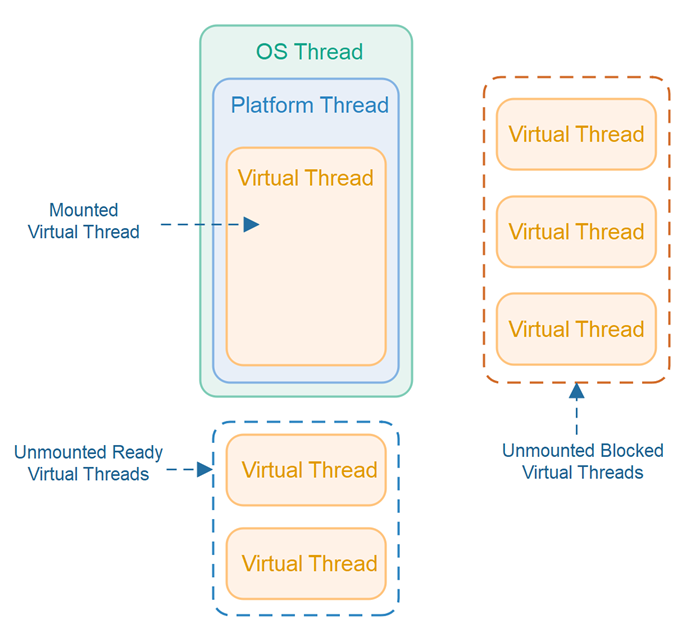The Unstoppable Evolution of the Java Virtual Machine
For decades, the Java Virtual Machine (JVM) has been the bedrock of enterprise software, renowned for its stability, performance, and the massive ecosystem surrounding the Java language. However, the narrative that the JVM is solely for Java is a relic of the past. Today, we are witnessing a vibrant JVM renaissance, a period of unprecedented innovation that is transforming it into a high-performance, polyglot platform for a new generation of applications. This evolution isn’t just about new Java versions; it’s a fundamental shift driven by ambitious OpenJDK projects, the rise of modern JVM languages, and the integration of cutting-edge fields like Artificial Intelligence.
The latest JVM news is filled with exciting developments that go far beyond incremental updates. From Project Loom’s game-changing virtual threads, which are revolutionizing Java concurrency news, to the growing adoption of dynamic and specialized languages that offer unparalleled flexibility, the JVM is more relevant than ever. This article delves into this modern landscape, exploring how developers can leverage polyglot capabilities, harness the power of modern Java features, and build next-generation applications on one of the world’s most robust and versatile runtimes. We’ll examine practical code examples, discuss the impact on the broader Java ecosystem news, and provide actionable insights for developers looking to stay ahead of the curve.
Section 1: The Polyglot JVM – A Platform for Many Languages
The JVM’s initial promise was “write once, run anywhere.” Today, that promise has evolved into “run *anything*, anywhere.” The platform’s sophisticated Just-In-Time (JIT) compilation, advanced garbage collection, and extensive tooling have made it an attractive target for language designers. This has led to a thriving ecosystem of languages that compile to JVM bytecode, each offering unique strengths while seamlessly interoperating with the vast collection of Java libraries and frameworks.
Why Go Polyglot on the JVM?
The primary driver for polyglot programming on the JVM is the ability to use the right tool for the right job without leaving the ecosystem. While Java remains a powerhouse for robust, scalable backend systems, other languages excel in different areas:
- Conciseness and Safety: Languages like Kotlin offer modern syntax, null safety, and functional programming features, reducing boilerplate and common errors like
NullPointerException. This has made it a favorite for Android development and increasingly for backend services with Spring Boot. - Dynamic Scripting and DSLs: Groovy provides a dynamic, flexible syntax that is perfect for build scripts (as seen in Gradle), testing, and creating Domain-Specific Languages (DSLs).
- Functional Purity: Scala offers a powerful type system and deep support for functional programming paradigms, making it ideal for data processing pipelines and complex, concurrent systems, often used with frameworks like Akka and Apache Spark.
- Modern Dynamic Languages: A new wave of languages is emerging, focusing on developer productivity, modern syntax, and multi-runtime capabilities, enabling code to run on the OS, in the cloud as serverless functions, or embedded within larger Java applications.
Seamless Interoperability in Practice
The magic of the polyglot JVM lies in its near-frictionless interoperability. A class written in Kotlin can be instantiated and used in Java as if it were a native Java class. This allows teams to introduce new languages incrementally without rewriting existing code.
Consider a simple Kotlin data class for representing a user:
// User.kt
package com.example.model;
data class User(val id: Long, val username: String, var email: String?)This single line in Kotlin generates a class with a constructor, getters for all properties, setters for `var` properties, and `equals()`, `hashCode()`, and `toString()` methods. Now, let’s use this Kotlin class from a Java application. Thanks to the shared bytecode, it’s completely transparent.

// Main.java
package com.example.app;
import com.example.model.User;
public class Application {
public static void main(String[] args) {
// Instantiate the Kotlin data class from Java
User user = new User(1L, "jdoe", "john.doe@example.com");
// Use the generated getters
System.out.println("User ID: " + user.getId());
System.out.println("Username: " + user.getUsername());
// Use the generated setter for the 'email' property
user.setEmail("jane.doe@example.com");
// The toString() method from the data class is automatically called
System.out.println("Updated User: " + user);
}
}This powerful interoperability is a core reason why the JVM continues to thrive. It fosters innovation by allowing new languages and ideas to flourish on a stable, battle-tested foundation.
Section 2: Modern Java’s Leap Forward with Project Loom
While the ecosystem of alternate JVM languages grows, Java itself is not standing still. The latest Long-Term Support (LTS) releases, particularly Java 17 news and the groundbreaking Java 21 news, have introduced features that fundamentally change how we write concurrent and scalable applications. The most significant of these is Project Loom, which delivered virtual threads and structured concurrency.
Virtual Threads: Concurrency Without the Complexity
For years, Java’s concurrency model was tied to platform threads, which are thin wrappers around operating system (OS) threads. OS threads are a scarce and heavy resource, limiting the number of concurrent tasks an application can handle. This led to complex, callback-based asynchronous programming models, as seen in the Reactive Java news, to achieve high scalability.
Java virtual threads news changes this paradigm completely. Virtual threads are lightweight threads managed by the JVM, not the OS. A single OS thread can run millions of virtual threads, allowing developers to write simple, synchronous-looking, blocking code that scales massively. This is a monumental shift for the entire Java concurrency news landscape.
Let’s see the difference in practice. Imagine we need to run 100,000 tasks that each perform a short blocking operation (like a network call). With traditional platform threads, this would be impossible as it would exhaust system resources.
import java.time.Duration;
import java.util.concurrent.Executors;
import java.util.stream.IntStream;
public class VirtualThreadsDemo {
public static void main(String[] args) throws InterruptedException {
// Using the new virtual-thread-per-task executor
try (var executor = Executors.newVirtualThreadPerTaskExecutor()) {
IntStream.range(0, 100_000).forEach(i -> {
executor.submit(() -> {
// Each task sleeps for 1 second, simulating a blocking I/O call
try {
Thread.sleep(Duration.ofSeconds(1));
} catch (InterruptedException e) {
Thread.currentThread().interrupt();
}
if (i % 10_000 == 0) {
System.out.println("Task " + i + " completed on thread: " + Thread.currentThread());
}
});
});
} // executor.close() will wait for all tasks to complete
System.out.println("All 100,000 tasks completed.");
}
}Running this code demonstrates that 100,000 concurrent blocking tasks can be launched with ease. The JVM efficiently “parks” the virtual thread when it blocks and “unparks” it when the operation completes, using the underlying OS thread for other work in the meantime. This simplifies code, improves readability, and makes high-throughput applications easier to build and maintain. Frameworks are rapidly adopting this, with the latest Spring Boot news highlighting full support for virtual threads in Spring Boot 3.2.
Section 3: The Expanding Frontier – GraalVM, Native Image, and AI
Beyond language and concurrency innovations, the JVM ecosystem is pushing boundaries in performance, startup time, and integration with emerging technologies like AI. At the forefront of this movement is GraalVM.
GraalVM: The Polyglot High-Performance VM

GraalVM is a high-performance JDK distribution that offers a suite of powerful features. Its advanced JIT compiler can deliver significant performance improvements for Java and other JVM languages. However, its most talked-about features are Native Image and its polyglot capabilities.
GraalVM Native Image compiles Java code ahead-of-time (AOT) into a standalone native executable. This executable starts almost instantly and uses a fraction of the memory of a traditional JVM application, making it perfect for serverless functions, command-line utilities, and microservices where startup time is critical.
Furthermore, GraalVM’s Polyglot API allows you to embed and run code from other languages like Python, JavaScript, and R directly within a Java application, with minimal overhead.
Here’s an example of using the GraalVM Polyglot API to execute a Python function from Java. This opens up a world of possibilities, allowing Java applications to leverage the vast ecosystem of Python libraries for data science and machine learning.
import org.graalvm.polyglot.*;
public class PolyglotExample {
public static void main(String[] args) {
// Create a polyglot context with access to the Python language
try (Context context = Context.newBuilder("python").allowAllAccess(true).build()) {
// Python code to define a simple function
String pythonCode = "def process_data(data):\n" +
" return f\"Processed: {data.upper()} from Python!\"";
context.eval("python", pythonCode);
// Look up the Python function from the context
Value processDataFunction = context.getBindings("python").getMember("process_data");
// Execute the Python function with a Java string as input
Value result = processDataFunction.execute("some important data");
// Convert the result back to a Java string and print it
String javaResult = result.asString();
System.out.println(javaResult); // Output: Processed: SOME IMPORTANT DATA from Python!
}
}
}The Rise of AI in the Java Ecosystem
For a long time, Python has dominated the AI/ML landscape. However, recent Java news shows a strong push to make Java a first-class citizen in this domain. Projects like Spring AI and LangChain4j are abstracting away the complexity of interacting with Large Language Models (LLMs) like GPT-4 and Claude.

These libraries provide a streamlined, Java-native developer experience for building AI-powered applications, from simple chatbots to complex RAG (Retrieval-Augmented Generation) systems. The latest Spring AI news highlights integrations with a wide range of models and vector stores, making it easier than ever for the millions of Spring developers to add generative AI capabilities to their applications. This trend is a testament to the adaptability of the Java ecosystem.
Section 4: Best Practices and Future-Proofing Your Skills
Navigating this rapidly evolving landscape requires a forward-thinking approach. The days of being just a “Java developer” are giving way to being a “JVM developer,” proficient in leveraging the full power of the platform.
Tips for Modern JVM Development
- Embrace the LTS Cadence: Keep up with the Long-Term Support releases. Migrating from Java 8 news to Java 11 news, then to 17, and now planning for 21 is crucial. Each LTS brings significant performance, security, and language improvements. Java 21 news, with virtual threads and structured concurrency, is a particularly compelling upgrade.
- Choose the Right JVM Distribution: The world of OpenJDK news is diverse. While Oracle provides a commercial JDK, there are excellent, free, TCK-verified builds from vendors like Adoptium (Eclipse Temurin), Azul Zulu, Amazon Corretto, and BellSoft Liberica. Choose one that fits your support and licensing needs.
- Modernize Your Build and Testing: Stay current with your tools. The latest Maven news and Gradle news often include support for new Java features and improved dependency management. Similarly, keeping your testing stack up-to-date with the latest JUnit news and Mockito news is essential for maintaining code quality.
- Think Concurrently, Write Simply: With virtual threads, default to using them for I/O-bound tasks. Write simple, blocking code and let the JVM handle the scalability. This is one of the most important pieces of Java wisdom tips news for modern application development.
- Explore Polyglot, but Be Pragmatic: Don’t add a new language to your stack just because you can. Evaluate whether its strengths (e.g., Kotlin’s conciseness, Groovy’s dynamism) provide a tangible benefit for a specific part of your application. Manage polyglot projects carefully using multi-module builds in Gradle or Maven.
Conclusion: The Dawn of a New Era for the JVM
The Java Virtual Machine is in the midst of a profound transformation. It has evolved from a single-language runtime into a dynamic, high-performance, polyglot platform that is actively embracing the future of software development. The introduction of virtual threads in Java 21 has redefined scalability, making it more accessible than ever. The rise of modern JVM languages provides developers with a rich palette of tools to solve complex problems efficiently. Finally, the burgeoning support for AI through libraries like Spring AI and LangChain4j ensures the ecosystem remains at the forefront of technological innovation.
For developers, this is an incredibly exciting time. The key takeaway is to embrace this evolution. Dive into the features of Java 21, explore a new JVM language like Kotlin, experiment with GraalVM Native Image for a side project, and consider how you can integrate AI into your next application. By continuously learning and adapting, you can harness the full power of the modern JVM to build the robust, scalable, and intelligent applications of tomorrow.

